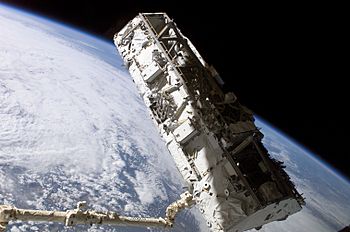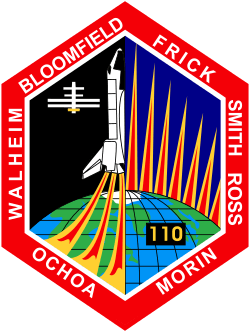STS-110 facts for kids

Canadarm2 grapples the first segment of the ISS' Integrated Truss Structure
|
|
| Mission type | ISS assembly |
|---|---|
| Operator | NASA |
| Mission duration | 10 days, 19 hours, 43 minutes, 38 seconds |
| Distance travelled | 7,240,000 kilometers (4,500,000 mi) |
| Orbits completed | 171 |
| Spacecraft properties | |
| Spacecraft | Space Shuttle Atlantis |
| Launch mass | 116,609 kilograms (257,079 lb) |
| Landing mass | 91,016 kilograms (200,657 lb) |
| Payload mass | 13,132 kilograms (28,951 lb) |
| Crew | |
| Crew size | 7 |
| Members |
|
| Start of mission | |
| Launch date | 8 April 2002 20:44:19 UTC |
| Launch site | Kennedy LC-39B |
| End of mission | |
| Landing date | 19 April 2002 16:26:57 UTC |
| Landing site | Kennedy SLF Runway 33 |
| Orbital parameters | |
| Reference system | Geocentric |
| Regime | Low Earth |
| Perigee | 155 kilometres (96 mi) |
| Apogee | 225 kilometres (140 mi) |
| Inclination | 51.6 degrees |
| Period | 88.3 minutes |
| Docking with ISS | |
| Docking port | PMA-2 (Destiny forward) |
| Docking date | 10 April 2002 16:05 UTC |
| Undocking date | 17 April 2002 18:31 UTC |
| Time docked | 7 days, 2 hours, 26 minutes |
  In front, (L-R): Stephen N. Frick, Ellen L. Ochoa, Michael J. Bloomfield; In the back, (L-R): Steven L. Smith, Rex J. Walheim, Jerry L. Ross and Lee M. E. Morin. |
|
STS-110 was a Space Shuttle mission that flew to the International Space Station (ISS) in April 2002. The mission lasted for 10 days and was carried out by the Space Shuttle Atlantis. Its main goal was to add a very important part to the space station, helping it grow bigger.
Contents
What Was the STS-110 Mission?
The main purpose of the STS-110 mission was to deliver and attach a large piece of equipment called the S0 Truss to the Destiny Laboratory Module on the International Space Station (ISS). Think of the S0 Truss as the "backbone" of the station's main structure. Other parts, like the S1 and P1 truss segments, were added to this backbone in later missions.
This mission also brought the Mobile Transporter (MT) to the ISS. The MT is a special platform that weighs about 885 kilograms (1,950 pounds). It can slide along rails on the station's truss structure. Later, during the STS-111 mission, the Mobile Base System (MBS) was attached to the MT. This whole system, called the Mobile Servicing System (MSS), allows the Canadarm2 robotic arm to move along the entire length of the station's main structure. This helps astronauts build and maintain the ISS.
The Crew of STS-110
Seven astronauts were part of the STS-110 crew. They worked together to complete the mission's goals.
- Commander: Michael J. Bloomfield
- Pilot: Stephen N. Frick
- Mission Specialist 1: Rex J. Walheim
- Mission Specialist 2: Ellen L. Ochoa
- Mission Specialist 3: Lee M. E. Morin
- Mission Specialist 4: Jerry L. Ross
- Mission Specialist 5: Steven L. Smith
One of the astronauts, Jerry L. Ross, made history on this mission. When Atlantis launched, he became the first person to travel to space seven times!
Launch Day Excitement
The launch of Space Shuttle Atlantis for the STS-110 mission happened on April 8, 2002. It lifted off from Launch Complex 39B in Florida.
There was a small delay before launch. A few days earlier, on April 4, the launch was put on hold because of a small leak in a hydrogen fuel line. On April 8, the countdown stopped for a short time just five minutes before liftoff due to a computer issue. However, the team quickly fixed it, and the countdown started again. Atlantis successfully launched with only 11 seconds left in its launch window!
This mission was also special because Atlantis was the first shuttle to use upgraded "Block II" main engines. These new engines had better fuel pumps and stronger parts. The goal was to make the engines more powerful, safer, and more reliable for future space flights.
Spacewalks: Working Outside the Station
During the STS-110 mission, astronauts performed four spacewalks, also known as Extravehicular Activities (EVAs). These spacewalks were crucial for installing the S0 Truss and preparing the station for future additions.
| Spacewalk | Astronauts | Date | Duration | Main Task |
|---|---|---|---|---|
| EVA 1 | Steven Smith Rex Walheim |
April 11, 2002 | 7 hours, 48 minutes | Installed the S0 Truss onto the Destiny Lab. |
| EVA 2 | Jerry Ross Lee Morin |
April 13, 2002 | 7 hours, 30 minutes | Continued work on installing the S0 Truss. |
| EVA 3 | Steven Smith Rex Walheim |
April 14, 2002 | 6 hours, 27 minutes | Prepared the Canadarm2 robotic arm to work with the new S0 Truss. |
| EVA 4 | Jerry Ross Lee Morin |
April 16, 2002 | 6 hours, 37 minutes | Installed hardware for future spacewalks. |
Images for kids
-
The three newly enhanced Space Shuttle Main Engines ignite to launch Space Shuttle Atlantis, 8 April 2002
See also
 In Spanish: STS-110 para niños
In Spanish: STS-110 para niños





